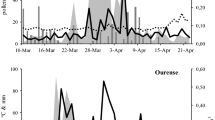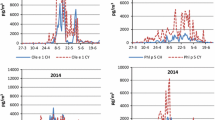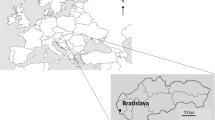Abstract
The Poaceae family, including grasses, comprises several cosmopolitan and allergenic species. The aim of this study was to determine the correlations between Poaceae pollen and Phl p 5 allergen concentrations in two cities with different geographical and climatic properties in Turkey. Pollen were collected from Burkard traps in Ankara and Zonguldak. Phl p 5 sampling was carried out between March and October in both 2015 and 2016 using a BGI900 Cascade High Volume Air Sampler (900 L/min.). The concentrations of Phl p 5 were measured by the enzyme-linked immunosorbent assay (ELISA) technique. The annual sum of Poaceae pollen (pollen index) during 2015–2016 was 5454 in Ankara and 4142 in Zonguldak. The total Phl p 5 concentration was 1309 pg/m3 in Zonguldak, whereas it was 8181 pg/m3 in Ankara over 2 years. About 90% of the allergen was found in the fraction with particulate matter (PM) > 10 μm in both cities. It was found that the main meteorological parameter which affected pollen and Phl p 5 was temperature in both stations. Rainfall was also found to be important for Zonguldak, due to its climatic and geographic properties. Lastly, we suggest that the primary wind direction, which is from the south of Zonguldak, could have a ‘drift effect’ for allergens because of the airborne pollen concentrations and the dates on which the allergen is released into the atmosphere. The wind direction may be an important factor in the distribution of allergen and pollen grains in stations, especially those with a hilly topography.









Similar content being viewed by others
References
Acar A, Alan Ş, Kaplan A et al (2017) General trends in atmospheric pollen concentration in the high populated city of Ankara, Turkey. Karaelmas Fen Ve Mühendis Derg 7:40–46
Akaydin G, Erik S (2002) Flora of Ankara City. Hacet J Biol Chem 31:35–93
Akman Y, Ketenoǧlu O (1986) The climate and vegetation of Turkey. Proc R Soc Edinb Sect B Biol Sci 89:123–134
Andersson K, Lidholm J (2003) Characteristics and immunobiology of grass pollen allergens. Int Arch Allergy Immunol 130:87–107. https://doi.org/10.1159/000069013
Bastl K, Kmenta M, Pessi A-M et al (2016) First comparison of symptom data with allergen content (Bet v 1 and Phl p 5 measurements) and pollen data from four European regions during 2009–2011. Sci Total Environ 548:229–235
Bıçakçı A, Çelenk S, Altunoğlu MK et al (2009) Allergenic airborne Gramineae (grass) pollen concentrations in Turkey. Asthma Allergy Immunol 7:90–99
Bosch-Cano F, Bernard N, Sudre B, Gillet F, Thibaudon M, Richard H, Badot PM, Ruffaldi P (2011) Human exposure to allergenic pollens: a comparison between urban and rural areas. Environ Res 111:619–625
Bostanci L, Türktas I, Türkyilmaz C (1999) Sensitization to aeroallergens in Ankara, Turkey. Allergy 54:1332–1334
Buters J, Prank M, Sofiev M, Pusch G, Albertini R, Annesi-Maesano I, Antunes C, Behrendt H, Berger U, Brandao R, Celenk S, Galan C, Grewling Ł, Jackowiak B, Kennedy R, Rantio-Lehtimäki A, Reese G, Sauliene I, Smith M, Thibaudon M, Weber B, Cecchi L (2015) Variation of the group 5 grass pollen allergen content of airborne pollen in relation to geographic location and time in season. J Allergy Clin Immunol 136:87–95.e6. https://doi.org/10.1016/j.jaci.2015.01.049
Buters JTM, Thibaudon M, Smith M, Kennedy R, Rantio-Lehtimäki A, Albertini R, Reese G, Weber B, Galan C, Brandao R, Antunes CM, Jäger S, Berger U, Celenk S, Grewling Ł, Jackowiak B, Sauliene I, Weichenmeier I, Pusch G, Sarioglu H, Ueffing M, Behrendt H, Prank M, Sofiev M, Cecchi L (2012) Release of Bet v 1 from birch pollen from 5 European countries. Results from the HIALINE study. Atmos Environ 55:496–505. https://doi.org/10.1016/j.atmosenv.2012.01.054
Buters JTM, Weichenmeier I, Ochs S, Pusch G, Kreyling W, Boere AJF, Schober W, Behrendt H (2010) The allergen Bet v 1 in fractions of ambient air deviates from birch pollen counts. Allergy 65:850–858. https://doi.org/10.1111/j.1398-9995.2009.02286.x
Çelik G, Mungan D, Abadoğlu Ö et al (2004) Direct cost assessments in subjects with seasonal allergic rhinitis living in Ankara, Turkey. Allergy Asthma Proc 25:107–113
Davis PH (1965) 1985. Flora of Turkey and the East Aegean Islands. Vol. 1-9. Edinb Univ Edinb Press 140:3–36
D’Amato G, Liccardi G, Frenguelli G (2007) Thunderstorm-asthma and pollen allergy. Allergy 62:11–16. https://doi.org/10.1111/j.1398-9995.2006.01271.x
De Linares C, Díaz de la Guardia C, Nieto Lugilde D, Alba F (2010) Airborne study of grass allergen (Lol p 1) in different-sized particles. Int Arch Allergy Immunol 152:49–57. https://doi.org/10.1159/000260083
De Linares C, Nieto-Lugilde D, Alba F et al (2007) Detection of airborne allergen (Ole e 1) in relation to Olea europaea pollen in S Spain. Clin Exp Allergy J Br Soc Allergy Clin Immunol 37:125–132. https://doi.org/10.1111/j.1365-2222.2006.02620.x
Dogan H, Cabi E, Doğan M (2016) Mapping and analyzing the spatial distribution of the tribe Triticeae Dumort. (Poaceae) in Turkey. Turk J Bot 40:1–10. https://doi.org/10.3906/bot-1604-11
Emberlin J, Savage M, Woodman R (1993) Annual variations in the concentrations of Betula pollen in the London area, 1961–1990. Grana 32:359–363. https://doi.org/10.1080/00173139309428965
Erkara IP, Cingi C, Ayranci U, Gurbuz KM, Pehlivan S, Tokur S (2009) Skin prick test reactivity in allergic rhinitis patients to airborne pollens. Environ Monit Assess 151:401–412. https://doi.org/10.1007/s10661-008-0284-8
Fischer S, Grote M, Fahlbusch B et al (1996) Characterization of Phl p 4, a major timothy grass (Phleum pratense) pollen allergen. J Allergy Clin Immunol 98:189–198
Flicker S, Vrtala S, Steinberger P et al (2000) A human monoclonal IgE antibody defines a highly allergenic fragment of the major timothy grass pollen allergen, Phl p 5: molecular, immunological, and structural characterization of the epitope-containing domain. J Immunol Baltim Md 1950 165:3849–3859
García-Mozo H (2017) Poaceae pollen as the leading aeroallergen worldwide: a review. Allergy 72:1849–1858. https://doi.org/10.1111/all.13210
García-Mozo H, Galán C, Belmonte J et al (2009) Predicting the start and peak dates of the Poaceae pollen season in Spain using process-based models. Agric For Meteorol 149:256–262. https://doi.org/10.1016/j.agrformet.2008.08.013
González Parrado Z, Fernández-González D, Camazón B, Valencia-Barrera RM, Vega-Maray AM, Asturias JA, Monsalve RI, Mandrioli P (2014) Molecular aerobiology - Plantago allergen Pla l 1 in the atmosphere. Ann Agric Environ Med AAEM 21:282–289. https://doi.org/10.5604/1232-1966.1108592
Güner A, Aslan S, Ekim T et al (2012) Türkiye bitkileri listesi (damarlı bitkiler). Nezahat Gökyiğit Bot Bahçesi Ve Flora Araştırmaları Derneği Yayını Istanb:47–83
Hirst JM (1952) An automatic volumetric spore trap. Ann Appl Biol 39:257–265. https://doi.org/10.1111/j.1744-7348.1952.tb00904.x
Ianovici N (2015) Relation between Poaceae pollen concentrations and meteorological factors during 2000–2010 in Timisoara, Romania. Acta Agrobot 68:373–381. https://doi.org/10.5586/aa.2015.033
Jaggi KS, Ekramoddoullah AK, Kisil FT (1989) Allergenic fragments of ryegrass (Lolium perenne) pollen allergen Lol p IV. Int Arch Allergy Appl Immunol 89:342–348
Jochner S, Lüpke M, Laube J, Weichenmeier I, Pusch G, Traidl-Hoffmann C, Schmidt-Weber C, Buters JTM, Menzel A (2015) Seasonal variation of birch and grass pollen loads and allergen release at two sites in the German Alps. Atmos Environ 122:83–93. https://doi.org/10.1016/j.atmosenv.2015.08.031
Kaplan A (2004) Airborne pollen grains in Zonguldak, Turkey, 2001-2002. Acta Bot Sin 46:668–674
Laaidi M, Laaidi K, Besancenot J-P, Thibaudon M (2003) Ragweed in France: an invasive plant and its allergenic pollen. Ann Allergy Asthma Immunol Off Publ Am Coll Allergy Asthma Immunol 91:195–201. https://doi.org/10.1016/S1081-1206(10)62177-1
Makra L, Juhász M, Borsos E, Béczi R (2004) Meteorological variables connected with airborne ragweed pollen in Southern Hungary. Int J Biometeorol 49:37–47
Mari A (2003) Skin test with a timothy grass (Phleum pratense) pollen extract vs. IgE to a timothy extract vs. IgE to rPhl p 1, rPhl p 2, nPhl p 4, rPhl p 5, rPhl p 6, rPhl p 7, rPhl p 11, and rPhl p 12: epidemiological and diagnostic data. Clin Exp Allergy J Br Soc Allergy Clin Immunol 33:43–51
Mohapatra SS, Lockey RF, Shirley S (2005) Immunobiology of grass pollen allergens. Curr Allergy Asthma Rep 5:381–387
Pablos I, Wildner S, Asam C, Wallner M, Gadermaier G (2016) Pollen allergens for molecular diagnosis. Curr Allergy Asthma Rep 16:31
Parrado ZG, Barrera RMV, Rodríguez CRF et al (2009) Alternative statistical methods for interpreting airborne Alder (Alnus glutimosa (L.) Gaertner) pollen concentrations. Int J Biometeorol 53:1–9
Peternel R, Srnec L, Čulig J, Hrga I, Hercog P (2006) Poaceae pollen in the atmosphere of Zagreb (Croatia), 2002–2005. Grana 45:130–136. https://doi.org/10.1080/00173130600662114
Piotrowska K, Kubik-Komar A (2012) The effect of meteorological factors on airborne Betula pollen concentrations in Lublin (Poland). Aerobiologia 28:467–479
Plaza MP, Alcázar P, Hernández-Ceballos MA, Galán C (2016) Mismatch in aeroallergens and airborne grass pollen concentrations. Atmos Environ 144:361–369. https://doi.org/10.1016/j.atmosenv.2016.09.008
R Core Team (2013) R: a language and environment for statistical computing. R Foundation for Statistical Computing, Vienna
Rodríguez-Rajo FJ, Jato V, González-Parrado Z, Elvira-Rendueles B, Moreno-Grau S, Vega-Maray A, Fernández-González D, Asturias JA, Suárez-Cervera M (2011) The combination of airborne pollen and allergen quantification to reliably assess the real pollinosis risk in different bioclimatic areas. Aerobiologia 27:1–12. https://doi.org/10.1007/s10453-010-9170-2
Şen Z (2018) Crossing trend analysis methodology and application for Turkish rainfall records. Theor Appl Climatol 131:285–293
Sin BA, Inceoglu O, Mungan D, Çelik G, Kaplan A, Misirligil Z (2001) Is it important to perform pollen skin prick tests in the season? Ann Allergy Asthma Immunol Off Publ Am Coll Allergy Asthma Immunol 86:382–386. https://doi.org/10.1016/S1081-1206(10)62482-9
Soreng RJ, Peterson PM, Romaschenko K et al (2015) A worldwide phylogenetic classification of the Poaceae (Gramineae). J Syst Evol 53:117–137. https://doi.org/10.1111/jse.12150
Stach A, Smith M, Baena JP, Emberlin J (2008) Long-term and short-term forecast models for Poaceae (grass) pollen in Poznań, Poland, constructed using regression analysis. Environ Exp Bot 62:323–332
Stein AF, Draxler RR, Rolph GD, Stunder BJB, Cohen MD, Ngan F (2015) NOAA’s HYSPLIT atmospheric transport and dispersion modeling system. Bull Am Meteorol Soc 96:2059–2077. https://doi.org/10.1175/BAMS-D-14-00110.1
Suphioglu C (1998) Thunderstorm asthma due to grass pollen. Int Arch Allergy Immunol 116:253–260
Weber RW (2004) Cross-reactivity of pollen allergens. Curr Allergy Asthma Rep 4:401–408. https://doi.org/10.1007/s11882-004-0091-4
Acknowledgements
The authors gratefully acknowledge the NOAA Air Resources Laboratory (ARL) for the provision of the HYSPLIT transport and dispersion model and/or READY website (http://www.ready.noaa.gov) used in this study. This research was supported by the Scientific and Technological Research Council of Turkey (TÜBİTAK), Grant No: KBAG-113Z762. We appreciate Ferudun Koçer for his contributions to our study.
Author information
Authors and Affiliations
Corresponding author
Electronic supplementary material
ESM 1
(DOCX 8 kb)
Rights and permissions
About this article
Cite this article
Alan, Ş., Şahin, A.A., Sarışahin, T. et al. The effect of geographical and climatic properties on grass pollen and Phl p 5 allergen release. Int J Biometeorol 62, 1325–1337 (2018). https://doi.org/10.1007/s00484-018-1536-0
Received:
Revised:
Accepted:
Published:
Issue Date:
DOI: https://doi.org/10.1007/s00484-018-1536-0




